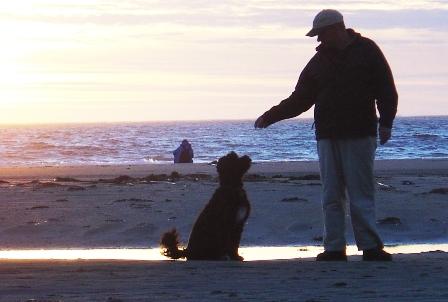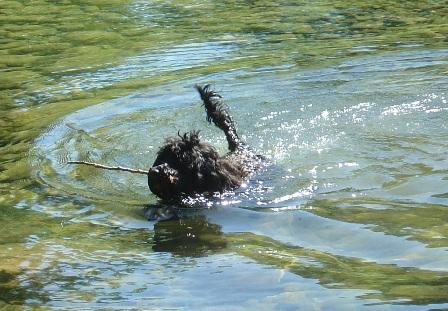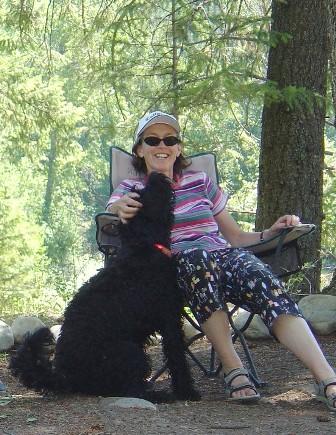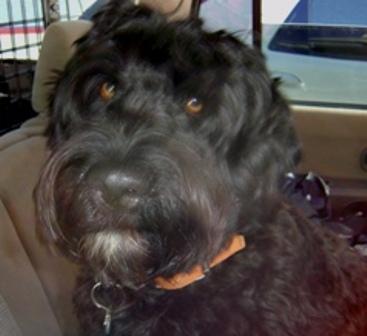When pawrents learn that their dog has bone cancer, they often second guess their decisions leading up to the diagnosis. They find themselves wondering “Why didn’t we see it? Maybe we should’ve done this…or that…” Many wonder; if we knew he had cancer sooner, would things be better?
 Sarah was one of those pawrents. She and her 5 year old Portuguese water dog, Jake, recently came to us through Tazzie, a mutual friend in Canada. Sarah posted in the forums, looking for advice when Jake’s spinal bone cancer became dramatically worse.
Sarah was one of those pawrents. She and her 5 year old Portuguese water dog, Jake, recently came to us through Tazzie, a mutual friend in Canada. Sarah posted in the forums, looking for advice when Jake’s spinal bone cancer became dramatically worse.
She and Jake had walked a long road up to the bone cancer diagnosis. His behaviors exhibited possible diagnoses ranging from a ruptured disc to arthritis. When cancer was finally discovered, Jake wasn’t an amputation candidate because the cancer (later inconclusively diagnosed as chondrosarcoma) was in his spine.
Sarah found little information online about bone cancer in the spine, and unfortunately we too made the same discovery. Sadly, in just eight weeks, Jake’s health rapidly declined and the intense pain was too much to bear. After a bone biopsy was taken, he could hardly walk and suffered from bouts of intense pain. Sarah released him from his pain on December 12th, just two days later.
 Afterward, Sarah told us that she was completely unprepared for the way in which bone cancer in the spine presents itself in dogs. It was distressing not to find even an ounce of hope or ways to cope.
Afterward, Sarah told us that she was completely unprepared for the way in which bone cancer in the spine presents itself in dogs. It was distressing not to find even an ounce of hope or ways to cope.
But Jake’s death will not be in vain. Sarah wrote the following summary of her experience, to help anyone else who might find themselves with a dog suspected of having spinal bone cancer. We are grateful for the time she took to help others in this way.
Please read on to learn about the symptoms, behaviors and progression of this devastating presentation of bone cancer.
Swim on, Jake, you will never be forgotten . . .
Primary Chondrosarcoma of the spine – Jake’s Story
by Sarah Crook
Written in the hope that reading it you will be more prepared to cope with this awful disease than I was. The progress of the disease from no symptoms to death took 8 weeks. The cancer was located in the C7 vertebra (lower neck).
Early signs (first two weeks):
- A stiffness that developed after 15 to 20 minutes walking. Jake woke up in the morning seemingly fine – the stiffness was only obvious with exercise and occurred even with moderate exercise, like leash walking. Round the house Jake’s activity seemed normal and the stiffness was not apparent (this pattern seems unlike what I have read about arthritis where the dog wakes stiff, then it gradually wears off).
- A reluctance to go up/downhill that I noticed when walking Jake off-leash. Jake still followed but lagged behind.
- A cautious approach to going up/down stairs especially after a walk when he had stiffened up
- Cautious approach to getting in and out of car – fairly subtle. Just a hesitation before jumping and a preference to climb in rather than jump..
- A reluctance to stretch his head down to eat or drink. Backed off and barked at his food bowl until I raised it up.
- Very subtle – I only thought of this in retrospect – sometimes a slight unsteadiness when he cocked his leg for a pee.
Middle period (middle four weeks):
- After 2 weeks Jake was seen by a vet who physically examined him and found stiffness in his neck and a reaction (growl/snap) when upper back was pressed hard. Soft tissue injury was suspected and Jake put on Metacam and restricted exercise.
- On Metacam he seemed livelier around the house and more playful – but the stiffness and stiff-legged gait still continued when exercised and as things progressed, would start after only 5mins. A video clip taken at this time shows his normal walk when setting out, then the stiff-legged ‘walking on eggshells’ gait that he would suddenly adopt; and his cautious approach to going down a step.
- After 14 days of Metacam and no obvious improvement, Jake was put on Robaxin – a muscle relaxant. Robaxin made him much WORSE. He was clearly uncomfortable in the house – standing looking miserable, seemingly afraid of sitting or lying down (as if he thought it would hurt – which it probably did). His back legs became noticeably weak and he hard difficulty climbing upstairs (ataxia). I was especially aware of him being restless through the night (prior to this he slept well) – he would sleep for a few hours then wake apparently in discomfort and take 5 or 10 minutes to lever himself up and settle into a new position. Later, I found out from the oncologist that this was not unexpected – Jake’s muscles would have been protecting the painful part of his spine, and with the muscle relaxant they could no longer do this.
- After 5 days took him off Robaxin and the vet put him back on Metacam. Ataxia lessened, slept well again, things seemed to improve – but in retrospect he did not recover to pre-Robaxin level. Jake started doing ‘girlie’ pees and if he tried to cock his leg consistently lost his balance. I later learned the weakness in his back legs and the uncoordinated gait (‘ataxia’) that developed were the result of the tumour and/or associated inflamed tissue compressing the spinal cord.
End Phase (last two weeks):
- Increasing unsteadiness of back legs so took Jake once more back to his vet. Same stiffness in neck and sore place on upper back. Blood samples were taken to rule out the slight chance of a tick born disease and vet referred Jake to a surgical specialist and a neurologist.
- Surgeon examined Jake and suspected ruptured disc – recommended MRI.
- Neurologist examined Jake and suspected lesion in lower neck and upper back (either two separate ones or one big one) Recommended CAT scan.
- Cat scan showed tumour in C7 vertebra about 2x2cm in size, and a biopsy was taken. I met with an oncologist and decided to have one radiation treatment to see if it would reduce the pain and inflammation. If not, I would have him put to sleep.
Last Two Days:
 Jake came home on a Thursday afternoon after having the CAT scan and bone biopsy the previous night. He was on Perkocet but a couple of hours after getting home had a bout of severe pain – later I thought this episode must be similar to ‘breakthrough’ pain suffered by human cancer victims.
Jake came home on a Thursday afternoon after having the CAT scan and bone biopsy the previous night. He was on Perkocet but a couple of hours after getting home had a bout of severe pain – later I thought this episode must be similar to ‘breakthrough’ pain suffered by human cancer victims.
He had two more of these attacks on Friday night and then early Saturday morning, in spite of having started on stronger pain relief (morphine and Gabapentin – and more Metacam, although he deteriorated so fast I never got around to adding this to the cocktail) and they all followed the same pattern – 5 to 10 minutes of increasingly fast panting, signs of acute pain (groaning and struggling to his feet to stand hunched over, head hanging, tongue lolling) lasting 10 – 15 minutes; 20 – 40 minutes of gradually winding down (I could get him to sit on my lap and would rub him and try to calm him). On Saturday I decided enough was enough, it was too late to try radiation therapy, and I had him put to sleep that afternoon…
In retrospect
- I am not sure if I wish I had asked for an X-ray early on and found the tumor sooner. Early diagnosis would have meant when he could still run around I would not have been limiting his exercise and keeping him on-leash all the time… and there would have been time to plan treatment such as radiation therapy. However, the bone biopsy would also have been done sooner and maybe even early on the consequences (huge increase in pain and decrease in mobility) would have been the same as below – see next point.
- I would not have had the bone biopsy done without much more careful consideration – I blame this for the rapid deterioration in Jake’s condition at the end – hugely increasing the pain and causing increased inflammation that severely impacted his mobility and comfort level: he could hardly walk when he came home his back-end was so uncoordinated and weak.
- I would have asked the oncologist for pain meds. to deal with the ‘breakthrough’ pain (if indeed that was what it was). If there aren’t any effective drugs to deal with it, I would have at least discussed what I could/should do if these attacks happened.
- I would have had the consulting oncologist leave a prescription for stronger pain medication with an 24hr animal clinic in case Jake suddenly got worse in the night or at the weekend when she could not be contacted.
- I would have got the contact details of a call-out vet who could come and put Jake to sleep when Jake’s own vet clinic was closed….
 Jake’s own vet and the specialists he referred me to were consistently caring and conscientious. Both contacted me this week after I wrote to them raising some of the issues I mention above. They spent nearly an hour going through things with me, so I think they deserve credit for this, especially my vet, as he must have known the length of time in getting to a diagnosis would be a tricky subject to discuss.
Jake’s own vet and the specialists he referred me to were consistently caring and conscientious. Both contacted me this week after I wrote to them raising some of the issues I mention above. They spent nearly an hour going through things with me, so I think they deserve credit for this, especially my vet, as he must have known the length of time in getting to a diagnosis would be a tricky subject to discuss.
Not a happy end to a bright and loving creature. If you are facing the same I know reading the above will be distressing – but I hope it will help you make the right choices for your pet.
Best wishes, Sarah
Thank you Sarah for your story on Jake. How awful for both he AND you to go thru. My heart goes out to you…some of your story very much reminds me of my dog before I finally got a diagnosis…the intense pain…so horrible.
Take care Sarah.
Tracy, Maggie’s Mom
Such a sad story for you and Jake…….it seems to make no sense why suffering happens to such innocent creatures…..I agree on your comments about the bone biopsy…some can of worms are better left unopened. Hugs to you,
Gina